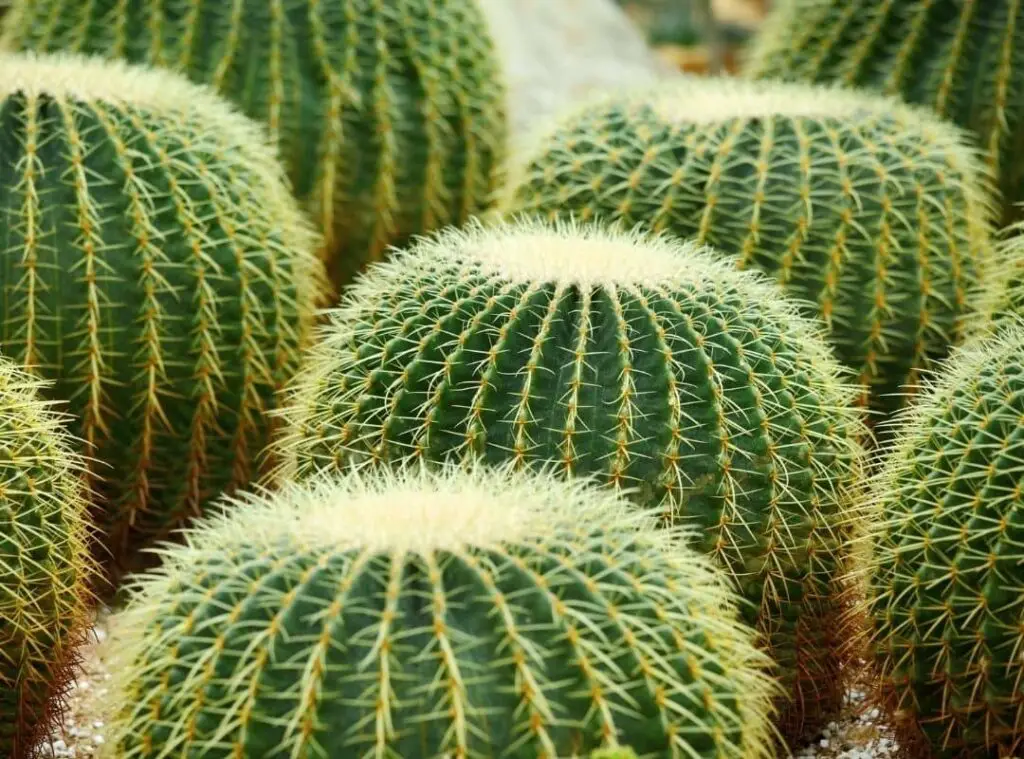Do you know how to stake a cactus? Let me explain it to you. In this article I am trying to provide you a complete guide on how to stake a cactus.
This article is designed for beginners in cactus gardening. But if you are an expert you can refresh your knowledge by going through this article. So let’s start.

Can you stake a cactus?
Cacti usually form in numerous shapes and sizes. For example, there are cactus like Golden spiked barrels which would form as huge balls on the ground.
On the other hand, there are tall cacti like Saguaro cacti which would rise into the sky. So, if you are growing cactus which are tall and which have a weak root system, chances are that they would tend to lean to one side.
Hence, you could use staking to overcome this condition. That will allow your precious cactus to grow healthy whilst ensuring that their roots are grown healthy.
How to stake a potted cactus
01. First you need to dig a hole right behind the cactus but right to the opposite side to where it has leaned. However, ensure that you do not injure the plants when doing this.
02. Next push a stake which is about 6 foot in size to the hole.
After that, fill it with soil. When you do this, ensure that one half of the stake is buried so that it will keep from bending with the weight of the plant. Further the stake you use for this should be a sturdy one like hardwood or bamboo which will help the cactus to stay upright.
03. Next take green horticultural tape and wrap it around both the stake and the cactus as well. Ensure that you are wearing protective gloves unless the spines of the cactus may harm you.
Furthermore, the tie you knot here should be loose and not tight. Refrain from pulling the tape too tight around the cactus as if not it will damage the outside surface of it.
04. Ultimately it will make the plants more prone towards the pest’s attacks and for the diseases.
05. Best is to leave the stake for two growing seasons.

How to stake a tall cactus
01. First and foremost, I recommend wearing protective gloves, safety goggles and a long-sleeved shirt and long pants so that the spines cannot pierce through your skin.
02. Next you need to create a collar to protect the stems. To do that simply you have to wrap non adhesive horticultural tape loosely around the center of the cactus and its spines. You may either knot it or staple the tape so that it will stay positioned.
03. Next you need to tap 8-foot-tall T stakes which are made of steel into the ground but opposite to the cactus stem. You may use a wooden mallet for this task.
04. Next you need to slide the fence post driver on one stake.
05. After that use the fence post driver handle and stake 3 feet into the ground.
06. Next once again drive the second stake 3 feet into the ground using that.
07. The cactus horticultural tape collar should be attached to the T stakes also. To do that you could use long pieces of horticultural tape.
08. Next you need to leave the T stakes in position for about three to six months. So that it would allow the cactus root system to recover.
09. Ultimately that will allow them to go right upward.
10. After that remove the horticultural tape off the cactus. You may use the scissors and remove the T stakes.
How to stake a large cactus
If you have a large cactus to stake, first you should fold a large piece of burlap which would resemble a look of wide belt shape.
The burlap should overlap itself for several times as that will increase the thickness. The Burlap will act as a cushion between the cactus and the stake.
Make sure that you wrap the burlap from 3-4 feet from the ground around the cactus. Keep in mind to wear the protective gears as mentioned above. If you have an extremely taller cactus, you need to place the burlap somewhat higher.
After that using a staple gun and staples and staple it to burlaps itself. Do not harm the plants when you do this.
If you happen to damage the cactus here, it will make the plants more attractive towards the pests and for other bacterial fungal infections.
Next, you should lean three 2 by 4 lumber pieces opposite to the cactus on the burlap cushion. Keep equal distances between each wood length when you do this. However, ensure that you keep a 45 degrees angle between the limber and the ground.
Finally, you need to dig holes at the lumber bases. Further bury the lumber ends in the holes well so that they will be sturdy against the cactus.
Further cover the lumber ends with soil. Ensure that you tap the soil properly so that the lumber would not move.

How to keep cactus from falling over
Your cactus may fall due to over watering, under watering , pest attacks, root rot or even due to over sized pots.
Usually, a healthy cactus would grow at a 90 degrees angle to the soil. That literally means the plants are getting the sufficient nutrients and right sunlight levels.
Having said that, chances are that they may still look healthy but leaning away from the sun. However , it is vital that you know as to what exactly caused your plants to fall. To elaborate further on these,
Root rot disease is what could cause the fungal infections and the bacterial infections. This could be commonly visible when you supply water in excess for the plants.
It would in fact result in the drooling. However, if you wish to ascertain whether root rot has caused the plants to fall.
The first thing you should do is check the plant’s roots. Check whether they have mushy, slimy and dark roots and if you find any your cactus may fall due to root rot only.
Ensure that you treat them well as if you do not treat them well, it would even create fatal impacts on the plants.
The best thing you could do here would be to uproot the plants and treat the damaged plant parts along with a fungicide.
Secondly, pest infestations from mealybugs, ants and other pests would also result in this. The pests would depend on the plant’s sap and would create so much trouble by creating them look unhealthy and deformed.
They would eat the plant parts and make the plants more vulnerable for fungal infections. Ultimately the plants would perish as well.
Lack of sunlight exposure is one more reason as to why the plant may fall off. Many of the cactus species have adapted to grow in brightly lit places where they can absorb sufficient sunlight along with extreme heat.
As such if you grow them as houseplants, you may find it difficult to provide the same conditions as they get in the natural habitat.
As such, if your indoor grown cactus keeps growing deprived of sufficient sunlight, chances are that they may end up drooping.
Damage from the freezing temperatures may also make the cactus fall. If you had mistakenly exposed the plants to frost, you may see the cactus plants parts have turned black. After a few weeks’ time, they would start to wilt and end up falling.
Fourthly, if you have grown them in a big pot, it would also make the plants droop and fall over. You need to always select a pot which is slightly bigger than your cactus.
Do not use way too big pots or too small pots to grow them. If you grow them in a small pot, cactus roots cannot absorb nutrients well .
Further there will be less space for them to grow as well. On the other hand, if you grow them in a large pot, the water absorption of the roots would not take place properly and the ultimate result would be the dropping of the plants.
Finally, the lapses in watering could also result in the dropping and the falling of the cactus.
Usually, you need to water your cactus twice a month during summer, spring and during some period of fall. On the other hand, you need to water them just once a month during winter.
If your cactus is suffering from underwatering, you could spot them carrying weak stems which would get discolored as well.
On the other hand, if you have over-watered them, chances are that your plants may droop and develop root rot due to the excessive moisture in the soil mix.
You could commonly witness this condition if you had grown them in a soil mix which has poor drainage. Besides , a poor draining pot would also result in this.

How to stop cactus from leaning
It is very important that you practice the right growing care tips so that they would grow straight up without leaning.
Considering that, ensure that you water the cactus properly. That literally means you should always water the plants if their soil is dry only.
Do not water them if their soil is soggy and unless it would lead to over watering. Further, you need to always choose a substrate and a pot which has excellent drainage.
If you figure out any presence of pests on your plants, the first thing is to check whether you can pick them up manually and kill them.
Besides, you may also use insecticidal soap and kill them. Next you should rinse them as well. Consider using a concentrated liquid dish soap for the rinsing purpose.
Repotting the cactus is one more fine idea to stop the cactus from leaning. Ensure that you conduct the repotting of the cactus once every two years so that it will have adequate space as well as fresh growing conditions to grow well.
Further, it will allow you to identify if there are any rotten plant parts and you may get rid of them as well.
Besides these factors, ensure that you fulfill the cactus light requirement as well. If you are a cacti lover, you may already know that they require bright sunlight to grow well.
Literally , it is critical that you mimic the same condition they get in the wild when you grow them indoors as well.
Finally, you should protect the plants from exposure to winter conditions too so that they will not go through this condition.
Read Next : Fence Cactus or Pachycereus Marginatus | A Unique Cactus |
